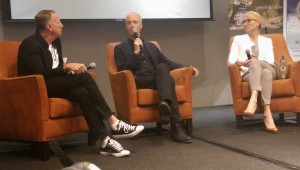
There was a celebratory buzz in the air at the 10th annual California Film Commission breakfast held Wednesday morning at the Sofitel Hotel in West Hollywood, in anticipation of the state’s greatly expanded film and television tax-incentive program going into effect at midyear. Presentations at the event centered on burgeoning expectations that by more than tripling previous subsidies to $330 million a year, employment in California’s television and film industry will be bolstered and the tide of runaway production to other states and countries will be stemmed.
“There’s an especially strong sense of optimism going on right now as we prepare to launch the new program,” Amy Lemisch, the executive director of the California Film Commission told some 200 attendees including the heads of many local film commissions from around the state. “The positive energy is palpable and our phones have not stopped ringing.”
Steve Dayan, secretary-treasurer of Teamsters local 399 and chairman of the California Film Commission struck a similar note in his opening remarks: “We are at the beginning of a new and very positive era for filmmaking in California.”
Under the old incentive program, which began in 2009, the CFC had only $100 million to hand out annually and recipients were selected based on a quirky lottery system. Because of the limited funds, there were many more applicants than winners and the rules on what kinds of productions were eligible were quite restrictive. According to Lemisch, a total of $800 million was handed out under the lottery regime, generating $6 billion in spending in the state. “That’s not a bad return on investment,” she noted. The new incentives, in theory, could triple the amount of in-state spending to almost $20 billion over a five-year span.
The new program replaces the lottery and puts into effect a point-ranking system that is tied in large part to how many industry jobs a production is expected to create. Big-budget feature films and one-hour television series, along with pilots, can now qualify. The budget cap for studio and independent films has been eliminated. There is also an additional 5% “uplift” incentive for productions that film outside of a 30-mile zone centered in Los Angeles. The same 5% dollop is available for a production’s visual effects and music scoring/recording spend within the state.
The breakfast concluded with a discussion by three production participants in Nightcrawler – director and screenwriter Dan Gilroy, and producers Jennifer Fox and David Lancaster – on the importance of tax incentives in letting them shoot the film, starring Jake Gyllenhaal, entirely in Los Angeles. Gilroy said he always wanted to shoot Nightcrawler in L.A. but Louisiana was under consideration for budgetary reasons. When the $8 million movie received a $2.3 million tax credit from the CFC that was the clincher. “It’s always more expensive to film in L.A.,” said the director, but noted that the expertise of local crews made it possible to shoot far more quickly than in the Bayou State. Added Fox, “This is a film where people had to take a pay cut. They wouldn’t have done that if they’d had to leave town.”





